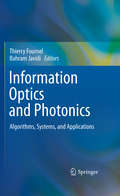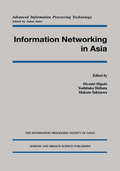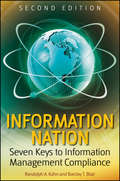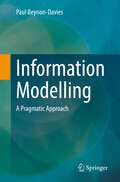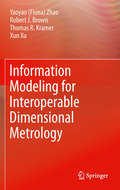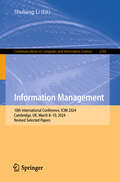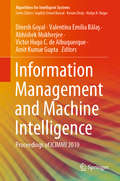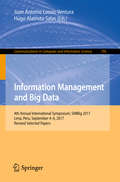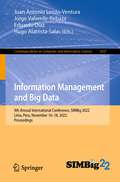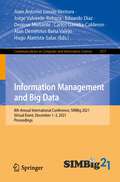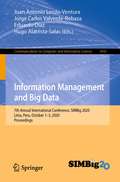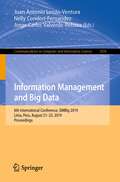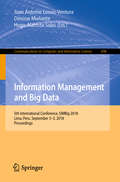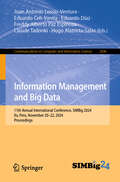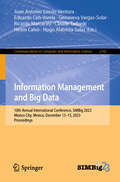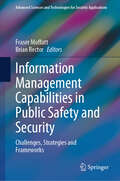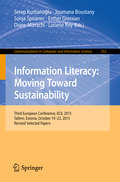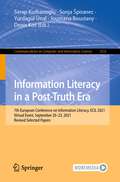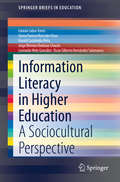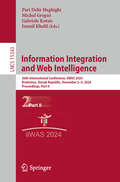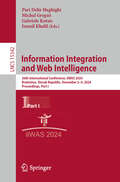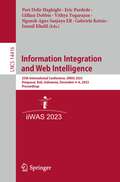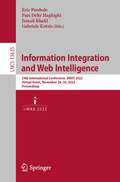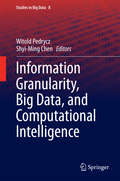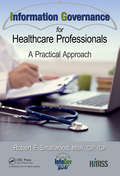- Table View
- List View
Information Optics and Photonics
by Bahram Javidi Thierry FournelThis book will address the advances, applications, research results, and emerging areas of optics, photonics, computational approaches, nano-photonics, bio-photonics, with applications in information systems. The objectives are to bring together novel approaches, analysis, models, and technologies that enhance sensing, measurement, processing, interpretation, and visualization of information. The book will concentrate on new approaches to information systems, including integration of computational algorithms, bio-inspired models, photonics technologies, information security, bio-photonics, and nano-photonics. Applications include bio-photonics, digitally enhanced sensing and imaging systems, multi-dimensional optical imaging and image processing, bio-inspired imaging, 3D visualization, 3D displays, imaging on nano-scale, quantum optics, super resolution imaging, photonics for biological applications, microscopy, information optics, and holographic information systems.
Information Networking in Asia
by Makoto Takizawa Hiroaki Higaki Yoshitaka ShibataThis volume comprises a collection of papers from the 12th international conference on information networking. (ICOIN-12) held in Tokyo 1998. Technical papers on communication networks and distributed systems were presented, along side internet-based electronic commerce network systems, academic research papers, e.g. high-speed communication ATM.
Information Nation
by Blair Barclay Kahn RandolphThis fully updated edition demonstrates how businesses can succeed in creating a new culture of information management compliance (IMC) by incorporating an IMC philosophy into a corporate governance structure. Expert advice and insight reveals the proven methodology that adopts the principles, controls, and discipline upon which many corporate compliance programs are built and explains how to apply this methodology to develop and implement IMC programs that anticipate problems and take advantage of opportunities. Plus, you'll learn how to measure information management compliance through the use of auditing and monitoring, following the proper delegation of program roles and components, and creating a culture of information management awareness.
Information Modelling: A Pragmatic Approach
by Paul Beynon-DaviesThis textbook provides solid guidance on how to produce information models in practice. Information modeling has become increasingly relevant as an approach for understanding the active role that data plays within business and management and promoting the planning of business activities. The text promotes a practical approach to information modelling based around the analysis of communicative practice within delimited domains of organization. The book chapters are designed to be read in sequence. The early chapters build an account of information modelling from the bedrock of a theory of information situations. Later chapters discuss a number of practical issues concerned with the application of this business analysis and design technique. The conclusion demonstrates a larger context for the application and importance of information modelling. Numerous in-text examples of the concepts of information modelling and their application are included throughout the text. A separate chapter is devoted to a range of exercises which the reader can use to test understanding and application of the technique. An appendix with solutions is also provided to support learning. Overall, this textbook provides a step-by-step introduction to information modelling for use in undergraduate and postgraduate modules in information systems, computer science and even digitally focused modules within business and management. No prerequisite knowledge is assumed on the part of the reader. Students and practitioners are tutored in the development of information modelling from first principles. The book covers all the core principles of both entity-relationship diagramming and class diagramming – the two major approaches to information modelling.
Information Modeling for Interoperable Dimensional Metrology
by Robert Brown Y Zhao T Kramer Xun XuDimensional metrology is an essential part of modern manufacturing technologies, but the basic theories and measurement methods are no longer sufficient for today's digitized systems. The information exchange between the software components of a dimensional metrology system not only costs a great deal of money, but also causes the entire system to lose data integrity. Information Modeling for Interoperable Dimensional Metrology analyzes interoperability issues in dimensional metrology systems and describes information modeling techniques. It discusses new approaches and data models for solving interoperability problems, as well as introducing process activities, existing and emerging data models, and the key technologies of dimensional metrology systems. Written for researchers in industry and academia, as well as advanced undergraduate and postgraduate students, this book gives both an overview and an in-depth understanding of complete dimensional metrology systems. By covering in detail the theory and main content, techniques, and methods used in dimensional metrology systems, Information Modeling for Interoperable Dimensional Metrology enables readers to solve real-world dimensional measurement problems in modern dimensional metrology practices.
Information Management: 10th International Conference, ICIM 2024, Cambridge, UK, March 8–10, 2024, Revised Selected Papers (Communications in Computer and Information Science #2102)
by Shuliang LiThis book constitutes the refereed proceedings of the 10th International Conference on Information Management, ICIM 2024, held in Cambridge, UK, during March 8–10, 2024. The 26 full papers and 12 short papers included in this book were carefully reviewed and selected from 139 submissions. They were organized in topical sections as follows: data based information systems and security management, design and development of digital information platform based on AI, knowledge based technological innovation and management, data oriented recommendation system and information management, process optimization and management in modern integrated information systems, intelligent information system and platform construction.
Information Management and Machine Intelligence: Proceedings of ICIMMI 2019 (Algorithms for Intelligent Systems)
by Abhishek Mukherjee Amit Kumar Gupta Dinesh Goyal Valentina Emilia Bălaş Victor Hugo C. de AlbuquerqueThis book features selected papers presented at the International Conference on Information Management and Machine Intelligence (ICIMMI 2019), held at the Poornima Institute of Engineering & Technology, Jaipur, Rajasthan, India, on December 14–15, 2019. It covers a range of topics, including data analytics; AI; machine and deep learning; information management, security, processing techniques and interpretation; applications of artificial intelligence in soft computing and pattern recognition; cloud-based applications for machine learning; application of IoT in power distribution systems; as well as wireless sensor networks and adaptive wireless communication.
Information Management and Big Data: Second Annual International Symposium, Simbig 2015, Cusco, Peru, September 2-4, 2015, And Third Annual International Symposium, Simbig 2016, Cusco, Peru, September 1-3, 2016, Revised Selected Papers (Communications In Computer And Information Science #656)
by Juan Antonio Lossio-Ventura Hugo Alatrista-SalasThis book constitutes the refereed proceedings of the 4th Annual International Symposium on Information Management and Big Data, SIMBig 2017, held in Lima, Peru, in September 2017.The 10 revised full papers presented were carefully reviewed and selected from 71 submissions. The papers address issues such as Data Science, Big Data, Data Mining, Natural Language Processing, Text Mining, Information Retrieval, Machine Learning, Semantic Web, Ontologies, Web Mining, Knowledge Representation and Linked Open Data, Social Web and Web Science, Information Visualization.
Information Management and Big Data: 9th Annual International Conference, SIMBig 2022, Lima, Peru, November 16–18, 2022, Proceedings (Communications in Computer and Information Science #1837)
by Juan Antonio Lossio-Ventura Hugo Alatrista-Salas Eduardo Díaz Jorge Valverde-RebazaThis book constitutes the refereed proceedings of the 9th Annual International Conference on Information Management and Big Data, SIMBig 2022, held in Lima, Peru, during November 16–18, 2022.The 18 full papers and 1 short paper included in this book were carefully reviewed and selected from 50 submissions. The volume presented novel methods for the analysis and management of large data, in fields like Artificial Intelligence (AI), Data Science, Machine Learning, Natural Language Processing, Semantic Web, Data-driven Software Engineering, Health Informatics.
Information Management and Big Data: 8th Annual International Conference, SIMBig 2021, Virtual Event, December 1–3, 2021, Proceedings (Communications in Computer and Information Science #1577)
by Juan Antonio Lossio-Ventura Hugo Alatrista-Salas Denisse Muñante Eduardo Díaz Jorge Valverde-Rebaza Carlos Gavidia-Calderon Alan Demétrius Baria ValejoThis book constitutes the refereed proceedings of the 8th International Conference on Information Management and Big Data, SIMBig 2021, held as a virtual event in December 2021. The 25 revised full papers and 2 revised short papers presented were carefully reviewed and selected from 67 submissions. The papers are organized in topical sections on data mining and applications; deep learning and applications; data-driven software engineering; health, NLP, and social media; image processing, machine learning, and semantic web.
Information Management and Big Data: 7th Annual International Conference, SIMBig 2020, Lima, Peru, October 1–3, 2020, Proceedings (Communications in Computer and Information Science #1410)
by Juan Antonio Lossio-Ventura Hugo Alatrista-Salas Jorge Carlos Valverde-Rebaza Eduardo DíazThis book constitutes the refereed proceedings of the 7th International Conference on Information Management and Big Data, SIMBig 2020, held in Lima, Peru, in October 2020.*The 32 revised full papers and 7 revised short papers presented were carefully reviewed and selected from 122 submissions. The papers address topics such as natural language processing and text mining; machine learning; image processing; social networks; data-driven software engineering; graph mining; and Semantic Web, repositories, and visualization. *The conference was held virtually.
Information Management and Big Data: 6th International Conference, SIMBig 2019, Lima, Peru, August 21–23, 2019, Proceedings (Communications in Computer and Information Science #1070)
by Juan Antonio Lossio-Ventura Nelly Condori-Fernandez Jorge Carlos Valverde-RebazaThis book constitutes the refereed proceedings of the 6th International Conference on Information Management and Big Data, SIMBig 2019, held in Lima, Peru, in August 2019.The 15 full papers and 16 short papers presented were carefully reviewed and selected from 104 submissions. The papers address issues such as data mining, artificial intelligence, Natural Language Processing, information retrieval, machine learning, web mining.
Information Management and Big Data: 5th International Conference, SIMBig 2018, Lima, Peru, September 3–5, 2018, Proceedings (Communications in Computer and Information Science #898)
by Juan Antonio Lossio-Ventura Hugo Alatrista-Salas Denisse MuñanteThis book constitutes the refereed proceedings of the 5th International Conference on Information Management and Big Data, SIMBig 2018, held in Lima, Peru, in September 2018. The 34 papers presented were carefully reviewed and selected from 101 submissions. The papers address issues such as data mining, artificial intelligence, Natural Language Processing, information retrieval, machine learning, web mining.
Information Management and Big Data: 11th Annual International Conference, SIMBig 2024, Ilo, Peru, November 20–22, 2024, Proceedings (Communications in Computer and Information Science #2496)
by Juan Antonio Lossio-Ventura Hugo Alatrista-Salas Eduardo Díaz Eduardo Ceh-Varela Claude Tadonki Freddy Paz EspinozaThis book constitutes the proceedings of the 11th Annual International Conference on Information Management and Big Data, SIMBig 2024, held in Ilo, Peru, during November 20–22, 2024. The 27 full papers and 1 short paper included in this book were carefully reviewed and selected from 102 submissions. They were organized in topical sections as follows: machine learning and deep learning; natural language processing; mining of social networks and online platforms; and signal and image processing.
Information Management and Big Data: 10th Annual International Conference, SIMBig 2023, Mexico City, Mexico, December 13–15, 2023, Proceedings (Communications in Computer and Information Science #2142)
by Juan Antonio Lossio-Ventura Hugo Alatrista-Salas Hiram Calvo Genoveva Vargas-Solar Eduardo Ceh-Varela Ricardo Marcacini Claude TadonkiThis book constitutes the refereed proceedings of the 10th Annual International Conference on Information Management and Big Data, SIMBig 2023, held in Mexico City, Mexico, during December 13–15, 2023. The 19 full papers and 6 short papers included in this book were carefully reviewed and selected from 64 submissions. SIMBig 2023 introduced innovative approaches for analyzing and handling datasets as well as new methods based on Artificial Intelligence (AI), Data Science, Machine Learning, Natural Language Processing, Semantic Web, Data-driven Software Engineering, Health Informatics, and more.
Information Management Capabilities in Public Safety and Security: Challenges, Strategies and Frameworks (Advanced Sciences and Technologies for Security Applications)
by Fraser Moffatt Brian RectorThis book provides thoughtful and extensively researched perspectives, to improve understanding of risks and rewards, and to outline strategies for developing and implementing mature information management capabilities focused on core public safety and security outcomes. Decision makers in Canadian public safety and security organizationslaw enforcement, fire and paramedic services, emergency management and national security, from local to national scopes and scales—are faced with an onslaught of rapidly changing technologies with uncertain application in an increasingly complex safety and security. How do these technologies fit into a strategic information management capability for public safety and security organizations? How do these technologies impact other areas of the organization? How can we harness these technologies to improve safety and security outcomes for Canadians? How would information governance strategy, governance and resourcing need to be structured and how would this function in the current operating environment and how would ethics, standards, privacy and information sharing and protection mechanisms need to be addressed in the face of compliance with legislation, regulation or policy? This volume makes the case for adopting strategic IM mindsets and practices intended to address a range of persistent IM challenges in public safety and security such as: building mature analytics and information sharing capabilities; building ethics, privacy, security and standards into IM governance aligned with public safety and security outcomes. The book is intended for senior decision makers in organizations that have responsibilities to delivery on core public safety and security outcomes and rely on information management to do so. These decision-makers face rapidly changing technologies in an increasingly complex business environment, face pressures for talent management and face risk-laden practices that impede or constrain the optimal use of information to achieve these outcomes for their organizations.
Information Literacy: Third European Conference, ECIL 2015, Tallinn, Estonia, October 19-22, 2015, Revised Selected Papers (Communications in Computer and Information Science #552)
by Serap Kurbanoğlu Joumana Boustany Sonja Špiranec Esther Grassian Diane Mizrachi Loriene RoyThis book constitutes the refereed proceedings of the Third European Conference on Information Literacy, ECIL 2015, held in Tallinn, Estonia, in October 2015. The 61 revised full papers presented were carefully reviewed and selected from 226 submissions. The papers are organized in topical sections on information literacy, environment and sustainability; workplace information literacy and knowledge management; ICT competences and digital literacy; copyright literacy; other literacies; information literacy instruction; teaching and learning information literacy; information literacy, games and gamification; information need, information behavior and use; reading preference: print vs electronic; information literacy in higher education; scholarly competencies; information literacy, libraries and librarians; information literacy in different context.
Information Literacy in a Post-Truth Era: 7th European Conference on Information Literacy, ECIL 2021, Virtual Event, September 20–23, 2021, Revised Selected Papers (Communications in Computer and Information Science #1533)
by Serap Kurbanoğlu Joumana Boustany Sonja Špiranec Yurdagül Ünal Denis KosThis book constitutes the refereed post-conference proceedings of the 7th European Conference on Information Literacy, ECIL 2021, held in online mode in September 2021.The 61 revised papers included in this volume were carefully reviewed and selected from 192 submissions. The papers are organized in the topical sections on information literacy in a post-truth era and news literacy; health literacy; data literacy; digital literacy and digital empowerment; other literacies; information literacy in different contexts; information literacy education in different sectors; information literacy instruction; assessment and evaluation of information literacy; academic integrity, plagiarism and digital piracy; information behaviour; information literacy, libraries and librarians; information literacy in different cultures and countries; information literacy and democracy, citizenship, active participation.
Information Literacy in Higher Education: A Sociocultural Perspective (SpringerBriefs in Education)
by Fabiola Cabra-Torres Gloria Patricia Marciales Vivas Harold Castañeda-Peña Jorge Winston Barbosa-Chacón Leonardo Melo González Oscar Gilberto Hernández SalamancaThis book presents an innovative theoretical and methodological approach to study information literacy in higher education contexts. While mainstream studies tend to see information literacy as a technical and universal process, this book proposes a theoretical and methodological framework to study information literacy from a sociocultural perspective, highlighting the importance of the social and cultural contexts in which information literacy develops.This situated approach demands that research data must be analysed in relation to the contexts in which they emerge, so the book proposes a research method based on the study of personal histories and stories, learning situations and intersubjective relationships to characterize the different information profiles of different information users. Adopting a multidisciplinary approach that combines contributions from educational research, psychology and information sciences, the authors first present a theoretical discussion to argue in favor of the sociocultural paradigm to study information literacy, then present their methodological proposal to observe informational competencies among higher education students, and finally present the results of an empirical study to identify different information literacy profiles among Latin American students and teachers.Breaking with the hegemonic paradigm in the field, Information Literacy in Higher Education – A Sociocultural Perspective provides useful and innovative tools to researchers working in different areas of the social sciences, such as education, psychology, linguistics and information sciences.
Information Integration and Web Intelligence: 26th International Conference, iiWAS 2024, Bratislava, Slovak Republic, December 2–4, 2024, Proceedings, Part II (Lecture Notes in Computer Science #15343)
by Ismail Khalil Michal Greguš Gabriele Kotsis Pari Delir HaghighiThe two-volume set LNCS 15342 and 15343 constitutes the refereed proceedings of the 26th International Conference on Information Integration and Web Intelligence, iiWAS 2024, held in Bratislava, Slovak Republic, during December 2–4, 2024. The 27 revised full papers and 25 short papers are presented in these proceedings were carefully reviewed and selected from 92 submissions. The papers are organized in the following topical sections: Volume I: Web Intelligence, Language Models, and AI-based Question Answerin; Blockchain, Peer Reviews, and Digital Transparency; Machine Learning in Healthcare, Climate Change, and Human Behavior; Sequence and Similarity Search Techniques; and Knowledge Graphs, Databases, and Ontologies. Volume II: Recommender Systems and Data Personalization; Digital Forensics, Journalism, and Echo Chambers; Human-Computer Interaction, Music Therapy, and User-Centric Systems; and Environmental and Geological Data Science.
Information Integration and Web Intelligence: 26th International Conference, iiWAS 2024, Bratislava, Slovak Republic, December 2–4, 2024, Proceedings, Part I (Lecture Notes in Computer Science #15342)
by Ismail Khalil Michal Greguš Gabriele Kotsis Pari Delir HaghighiThe two-volume set LNCS 15342 and 15343 constitutes the refereed proceedings of the 26th International Conference on Information Integration and Web Intelligence, iiWAS 2024, held in Bratislava, Slovak Republic, during December 2–4, 2024. The 27 revised full papers and 25 short papers are presented in these proceedings were carefully reviewed and selected from 92 submissions. The papers are organized in the following topical sections: Volume I: Web Intelligence, Language Models, and AI-based Question Answering; Blockchain, Peer Reviews, and Digital Transparency; Machine Learning in Healthcare, Climate Change, and Human Behavior; Sequence and Similarity Search Techniques; and Knowledge Graphs, Databases, and Ontologies. Volume II: Recommender Systems and Data Personalization; Digital Forensics, Journalism, and Echo Chambers; Human-Computer Interaction, Music Therapy, and User-Centric Systems; and Environmental and Geological Data Science.
Information Integration and Web Intelligence: 25th International Conference, iiWAS 2023, Denpasar, Bali, Indonesia, December 4–6, 2023, Proceedings (Lecture Notes in Computer Science #14416)
by Eric Pardede Ismail Khalil Gillian Dobbie Gabriele Kotsis Pari Delir Haghighi Ngurah Agus Sanjaya ER Vithya YogarajanThis book constitutes the refereed conference proceedings of the 25th International Conference on Information Integration and Web Intelligence, iiWAS 2023, organized in conjunction with the 21st International Conference on Advances in Mobile Computing and Multimedia Intelligence, MoMM2023, held in Denpasar, Bali, Indonesia, during December 4-6, 2023.The 24 full papers and 24 short papers presented in this book were carefully reviewed and selected from 96 submissions. The papers are divided into the following topical sections: business data and applications; data management; deep and machine Learning; generative AI; image data and knowledge graph; recommendation systems; similarity measure and metric; and topic and text matching.
Information Integration and Web Intelligence: 24th International Conference, iiWAS 2022, Virtual Event, November 28–30, 2022, Proceedings (Lecture Notes in Computer Science #13635)
by Eric Pardede Ismail Khalil Gabriele Kotsis Pari Delir HaghighiThis volume includes the papers presented at the 24th International Conference on Information Integration and Web Intelligence (iiWAS 2022), organized in conjunction with 24th International Conference on Advances in Mobile Computing & Multimedia Intelligence (MoMM2022).The dominant research focus of submitted papers was artificial intelligence and machine learning. The accepted papers presented advances and innovations in an array of areas such as internet of things, virtual and augmented reality, various business applications. iiWAS 2022 attracted 97 papers, from which the Program Committee selected 26 regular papers and 25 short papers.Due to safety concerns as well as other restrictions preventing travel and gatherings, it was decided to organize iiWAS 2022 as a virtual conference.
Information Granularity, Big Data, and Computational Intelligence
by Witold Pedrycz Shyi-Ming ChenThe recent pursuits emerging in the realm of big data processing, interpretation, collection and organization have emerged in numerous sectors including business, industry and government organizations. Data sets such as customer transactions for a mega-retailer, weather monitoring, intelligence gathering, quickly outpace the capacities of traditional techniques and tools of data analysis. The 3V (volume, variability and velocity) challenges led to the emergence of new techniques and tools in data visualization, acquisition, and serialization. Soft Computing being regarded as a plethora of technologies of fuzzy sets (or Granular Computing), neurocomputing and evolutionary optimization brings forward a number of unique features that might be instrumental to the development of concepts and algorithms to deal with big data. This carefully edited volume provides the reader with an updated, in-depth material on the emerging principles, conceptual underpinnings, algorithms and practice of Computational Intelligence in the realization of concepts and implementation of big data architectures, analysis, and interpretation as well as data analytics. The book is aimed at a broad audience of researchers and practitioners including those active in various disciplines in which big data, their analysis and optimization are of genuine relevance. One focal point is the systematic exposure of the concepts, design methodology, and detailed algorithms. In general, the volume adheres to the top-down strategy starting with the concepts and motivation and then proceeding with the detailed design that materializes in specific algorithms and representative applications. The material is self-contained and provides the reader with all necessary prerequisites and augments some parts with a step-by-step explanation of more advanced concepts supported by a significant amount of illustrative numeric material and some application scenarios to motivate the reader and make some abstract concepts more tangible.
Information Governance for Healthcare Professionals: A Practical Approach (HIMSS Book Series)
by Robert F. SmallwoodLike other critical organizational assets, information is a strategic asset that requires high level of oversight in order to be able to effectively use it for organizational decision-making, performance improvement, cost management, and risk mitigation. Adopting an information governance program shows a healthcare organization’s commitment to managing its information as a valued strategic asset. Information governance serves the dual purpose of optimizing the ability to extract clinical and business value from healthcare information while meeting compliance needs and mitigating risk. Healthcare organizations that have information governance programs will have a competitive edge over others and contributes to safety and quality of care, population health, operational efficiency and effectiveness, and cost reduction initiatives. This is a much-needed book in the healthcare market space. It will explain, in clear terms, how to develop, launch, and oversee an Information Governance program. It also provides advice and insights from leading IG, cybersecurity and information privacy professionals in healthcare.
